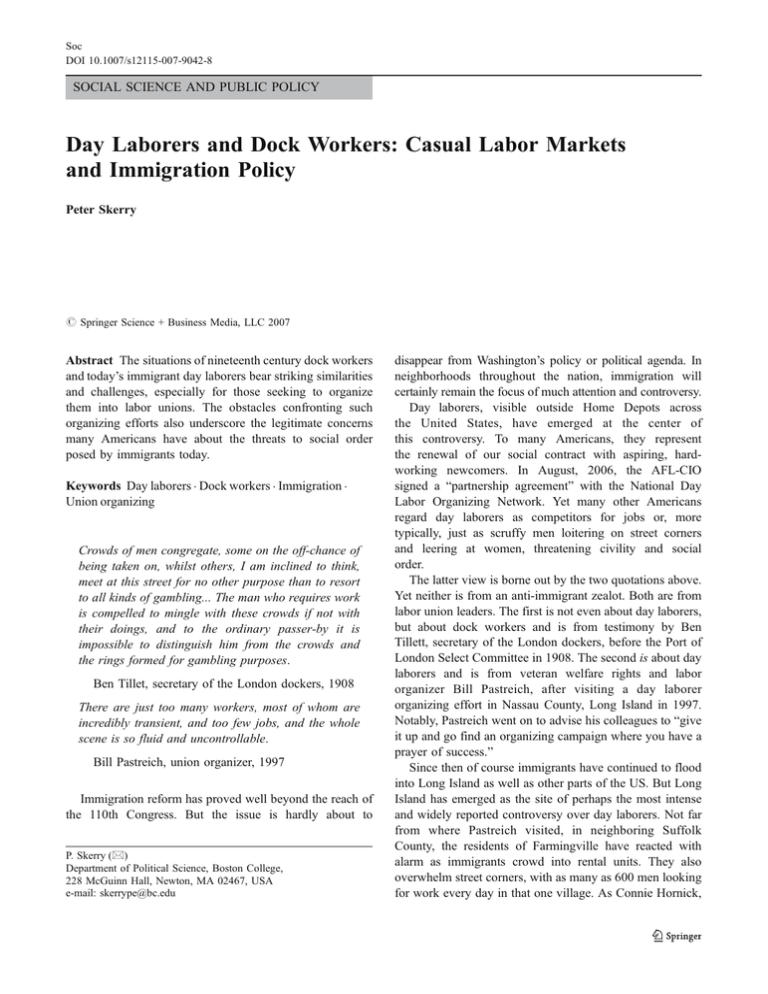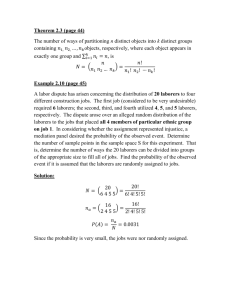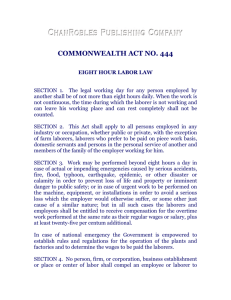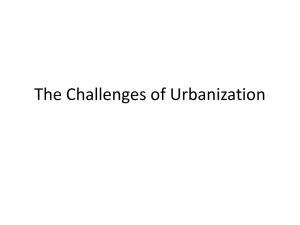Day Laborers and Dock Workers: Casual Labor Markets and Immigration Policy
advertisement

Soc DOI 10.1007/s12115-007-9042-8 SOCIAL SCIENCE AND PUBLIC POLICY Day Laborers and Dock Workers: Casual Labor Markets and Immigration Policy Peter Skerry # Springer Science + Business Media, LLC 2007 Abstract The situations of nineteenth century dock workers and today’s immigrant day laborers bear striking similarities and challenges, especially for those seeking to organize them into labor unions. The obstacles confronting such organizing efforts also underscore the legitimate concerns many Americans have about the threats to social order posed by immigrants today. Keywords Day laborers . Dock workers . Immigration . Union organizing Crowds of men congregate, some on the off-chance of being taken on, whilst others, I am inclined to think, meet at this street for no other purpose than to resort to all kinds of gambling... The man who requires work is compelled to mingle with these crowds if not with their doings, and to the ordinary passer-by it is impossible to distinguish him from the crowds and the rings formed for gambling purposes. Ben Tillet, secretary of the London dockers, 1908 There are just too many workers, most of whom are incredibly transient, and too few jobs, and the whole scene is so fluid and uncontrollable. Bill Pastreich, union organizer, 1997 Immigration reform has proved well beyond the reach of the 110th Congress. But the issue is hardly about to P. Skerry (*) Department of Political Science, Boston College, 228 McGuinn Hall, Newton, MA 02467, USA e-mail: skerrype@bc.edu disappear from Washington’s policy or political agenda. In neighborhoods throughout the nation, immigration will certainly remain the focus of much attention and controversy. Day laborers, visible outside Home Depots across the United States, have emerged at the center of this controversy. To many Americans, they represent the renewal of our social contract with aspiring, hardworking newcomers. In August, 2006, the AFL-CIO signed a “partnership agreement” with the National Day Labor Organizing Network. Yet many other Americans regard day laborers as competitors for jobs or, more typically, just as scruffy men loitering on street corners and leering at women, threatening civility and social order. The latter view is borne out by the two quotations above. Yet neither is from an anti-immigrant zealot. Both are from labor union leaders. The first is not even about day laborers, but about dock workers and is from testimony by Ben Tillett, secretary of the London dockers, before the Port of London Select Committee in 1908. The second is about day laborers and is from veteran welfare rights and labor organizer Bill Pastreich, after visiting a day laborer organizing effort in Nassau County, Long Island in 1997. Notably, Pastreich went on to advise his colleagues to “give it up and go find an organizing campaign where you have a prayer of success.” Since then of course immigrants have continued to flood into Long Island as well as other parts of the US. But Long Island has emerged as the site of perhaps the most intense and widely reported controversy over day laborers. Not far from where Pastreich visited, in neighboring Suffolk County, the residents of Farmingville have reacted with alarm as immigrants crowd into rental units. They also overwhelm street corners, with as many as 600 men looking for work every day in that one village. As Connie Hornick, Soc an outreach coordinator with a local church, told Professor Janice Fine: The major complaints of the community were that, (a) they couldn’t walk in the streets because the men were in huge masses and (b) that there were too many people in the houses. There was between twenty to thirty people in a house. These were their complaints and they were legitimate complaints. (emphasis added) This from a moderate who was eventually threatened by outraged anti-immigrant zealots. Before long, those complaints—along with less legitimate ones—erupted onto the front page of the New York Times and eventually onto the airwaves in a PBS documentary. Despite all the attention, there has been remarkably little analysis of the day laborer phenomenon. This essay is an attempt to gain some insight into this volatile issue by examining it from the neglected perspective of labor organizing. I intend to provide a much needed antidote to the romantic rhetoric that continues to cloud our thinking about immigration by reminding us of the genuine travail faced by immigrants today. Yet this organizing perspective also leads to greater appreciation of the challenges to social order posed by, in Pastreich’s term, the “transience” of the record numbers arriving here. The result is hopefully a new appreciation for what alarms so many Americans about immigrants today—however ineptly or even offensively those anxieties may sometimes be expressed. Today on the Corner The most comprehensive examination of day labor in the US is the National Day Labor Study, undertaken by a consortium of university researchers, led by UCLA economist Abel Valenzuela. On the Corner: Day Labor in the United States is based on a national survey of 2,660 workers, interviewed face-to-face in the summer of 2004 at 264 hiring sites in 139 municipalities, in 20 states and the District of Columbia. The study finds that “on any given day, approximately 117,600 workers are either looking for day-labor jobs or working as day laborers.” Three-fourths identify themselves as illegal immigrants. But with approximately twelve million illegals in the US today, this estimate of the total number of day laborers is almost certainly low. Nevertheless, if we accept this survey as a representative snap-shot of day laborers, we learn a lot. For example, day laborers are concentrated in the West, where 42% are found. The East accounts for 23%, and the Southeast 18%. Twelve percent are in the South, and only 4% of day laborers are in the Midwest. In the on-going debate over immigration, the public has focused on the legal status of day laborers. Equally striking is their national origin. Over 90% are Latino immigrants: 59% were born in Mexico, 28% in Central America. Another 4% hail from South America. Still, a surprising 7% were born in the US. Day laborers are relatively recent immigrants. About 20% of those interviewed have been in the US for less than a year. Another 40% have been here between 1 and 5 years. These data are consistent with the perception of both organizer Pastreich and the American public that day laborers are highly transient. Even more salient in the public mind is that day laborers are males, especially single or at least unattached males. In fact, the study reports that only 2% of day laborers are women. Moreover, 41% of day laborers indicate that they have never been married. Another 16% are either divorced, separated, or widowed. On the other hand, more than onethird are married, and an additional 7% are “living with a partner.” And almost two- thirds of all day laborers report having at least one child. (Indeed, 29% of these children are US citizens, presumably born here.) It is unclear how to interpret these numbers; particularly what proportion of day laborers is in stable domestic relationships. But one can certainly say that the public image of them as males not currently living in domestic situations is not obviously inaccurate or unfair. It should be no surprise that day laborers are neither well educated nor well paid. About three-fifths have 8 years or less of schooling. Another third have 9–12 years. The vast majority (83%) rely on day labor as their sole source of income; 70% search for work five or more days a week. Their median hourly wage (as of 2004) is $10. Day laborers who seek work full-time (four or more days a week) report monthly earnings of $700. But earnings are volatile. Median earnings in a good month for those seeking work full-time are around $1400; in a bad month just $500. Perhaps the most significant point here is that for most such workers, the day labor market is not where they end up. As the National Day Labor Study concludes, “a substantial share of day laborers are able to make the transition out of the day-labor market.” With 60% experiencing this as their first job in the US, “day labor is the entry point into the US labor market.” Indeed, 44% of day laborers have been at it for less than 1 year, 30% for 1– 3 years. At the same time, the overwhelming majority (86%) report that they are seeking regular, permanent employment. As we will see below, this reasonable expectation of moving out of this sector has big implications for efforts to organize these workers. Day laborers of course perform a variety of unskilled, manual jobs. About half are hired by individual homeowners (49%), slightly fewer by construction and land- Soc scaping contractors (46%). More than two-thirds (69%) have been hired repeatedly by the same employer, leading the National Day Labor Study to conclude that there is “a pattern of satisfied employers and willing workers.” Yet all is not as rosy as this suggests. Half of all day laborers (49%) report that in the 2 months prior to being surveyed they experienced not being paid anything for work completed. Forty-eight percent indicate that they were underpaid. This is a particular problem in the Midwest, where two-thirds of day laborers were denied wages, and 53% underpaid. Nationally, 44% of day laborers report being denied food, water, and breaks by employers. Twenty-eight percent say they were insulted or threatened by employers. Eighteen percent claim to have been subjected to violence. Then there is job safety. Day laborers routinely experience unsafe working conditions, especially in the hazardprone construction industry. One-fifth report getting injured on the job. Overall, about three-fourths consider their jobs dangerous. Again, the situation is worse in the Midwest, where fully one-third of day laborers claim work-related injuries, and 92% say their work is dangerous. (One reason why may be that in the Midwest day laborers are more heavily involved in dangerous roofing work than elsewhere.) Meanwhile, just 6% of injured day laborers report having their medical expenses covered by their employers’ workers’ compensation insurance. Controversies over day laborers have focused on the outdoor sites where they gather to find work. A Home Depot parking lot is the stereotypical example, but such sites are also near other businesses, gas stations, and busy street corners. They tend to operate year-round, though are most in use during the warmer spring and summer months. Since so many day laborers are hired by homeowners, it is no surprise that most sites are near residential neighborhoods. This also explains why the negative reaction has been so intense. The average day laborer site has 32 job seekers. But about one-fourth of sites have between 50–100 laborers, and 7% have more than 100. The survey also notes that these are inevitably undercounts, due to the ebb and flow of individuals over the course of a routine day. Valenzuela and his associates describe a typical site, which happens to be in Phoenix: Workers began gathering at the site before 6 a.m., and by 6:30 a.m. 32 job seekers were present. The number of available workers increased to 71 and 83 job seekers at 7:30 a.m. and 8:30 a.m., respectively, even as some workers left the site to work that day. Employers continued to select workers and by 9:30 a.m. the number of job seekers had fallen to 50. By 10:30 a.m., just 32 job seekers remained. Even at small cites, some number of job seekers remain behind, waiting for work. Such loitering, in addition to the crowds of men negotiating with passing motorists earlier in the day, creates the commotion that offends and even threatens neighbors and residents. Earlier, I mentioned a 600-person site, spread out over several blocks, in suburban Long Island. Other such large sites can be found in Langley Park, Maryland (350 job seekers), in Chicago (154), and in Phoenix (138). As the National Day Labor Study observes: “Large sites of this sort tend to have an extensive and shifting geography that often encompasses several blocks along the major thoroughfare where workers congregate. The radius might also extend several blocks from the epicenter of the hiring site as workers fan out in all directions in the hope of improving their chances of securing a job opportunity with an employer.” “Rationalizing a Chaotic Hiring Process” About a fifth of day laborers look for work through immigrant worker centers. These are typically an attempt, as researcher Janice Fine puts it, at “rationalizing a chaotic hiring process” by providing employers and workers indoor shelter and services—including legal advice (especially about immigration problems), ESL classes, and help recovering unpaid wages. In return, centers require registered participants to abide by specified rules and procedures. These generally include minimum wage rates, performance criteria for both employers and employees, and some kind of hiring queue that distributes employment opportunities equitably. Fine has identified about 122 such worker centers nationally. The National Day Labor Study reports that most such centers have come into existence since 2000, in response to the increased numbers of—and increased furor over—day laborers. Two-thirds of them are operated by community organizations; the remainder by church groups or even local government agencies. But whenever public officials are involved with such efforts, they are routinely denounced for condoning illegal immigration. Such programs are innovative in the context of today’s controversies. But they harken directly back to efforts at the end of the nineteenth century to reform chaotic, corrupt, and sometimes violent hiring practices on the docks, both here and in Britain. Hence, the observation of the British union leader quoted at beginning. Both day laborers and dock workers are involved in casual labor markets, characterized by frequently and widely fluctuating demand for labor. That demand is generated by time pressures, either simply to get a job completed or to move goods and avoid spoilage or storage fees. Workers are hired for specific jobs that may take a few hours or a few days. But when that job is done, more work is generally not available right away. Downtime is inevitable. Because the requisite skills and experience are low, there is invariably an Soc oversupply of workers competing for such jobs. This puts disproportionate discretion and power in the hands of whoever does the hiring. On the docks, this scenario has resulted in abuse and corruption. If the employer makes his own hiring decisions, he is prone to pick lackeys, retainers, or otherwise indulge his prejudices. His choices are likely to be shaped by bribes and kick-backs from favored workers. If a union attempts to operate in a casual labor market, it normally has two objectives: (1) to control the labor supply by restricting entry into the market, and (2) to influence or control the hiring process. Particularly with regard to hiring decisions, the process is prone to corruption. Indeed, collusion between union leaders and employers often arises—at the expense of rank-and-file workers. Coercion and violence are often part of the mix. Yesterday on the Docks This was the situation on US docks during the nineteenth century. Faced with the indicated choices, unions generally avoided the difficult path of limiting labor supply and opted instead for influencing the hiring process. The result was a system that gave something to everyone. The employers got their ships unloaded and goods moved with a minimum of delay and labor unrest. Union leaders got hefty salaries from inflated union dues and kick-backs from employers as well as workers. Yet collusive relationships between ship owners and union heads resulted in disgruntled workers, who were known to defy their leaders and engage in wildcat strikes. But even workers got something from this system. Because employers and union bosses did not face up to the difficult objective of limiting the supply of labor, individual workers undoubtedly got less work. But at least they did not have to worry about their buddies or themselves being excluded from the labor pool outright. Not everyone would find work on the docks every day, but at least they had the opportunity to look for work. Or so many convinced themselves. Moreover, some workers valued not getting tied permanently to any one employer. And for many, though not all, the pace of casual labor—working intensely for a time and then stopping—was an advantage. The downtime allowed those who had met their income targets to hang out with friends; others could seek additional work. Once such a system—with some disadvantages and some advantages for most everyone involved—fell into place, it was extremely difficult to dislodge, particularly with violence and criminal activity reinforcing the status quo. Nevertheless, significant reform of the docks was finally achieved on the West Coast. Faced with a restive and a relatively limited pool of laborers, shippers there exercised leadership and moved chaotic outdoor “shapeups” into indoor hiring halls, where jobs were distributed to workers in an orderly and equitable manner. The hitch was that the unions were excluded from this scenario. Eventually, they fought their way back in, and during the Depression there were intense disputes, including general strikes in San Francisco and Seattle. This time employers were persuaded to work with labor, under the controversial leadership of militant Harry Bridges. Tough choices were faced up to, and decisions taken. The supply of labor was reduced by means of a registration system that excluded marginal workers from the pool. But the linchpin was hiring halls that were operated jointly by employers and unions and featured a rigorously enforced system of job rotation. Eligible workers got equal opportunities at jobs and equivalent annual incomes. But to function, this arrangement required both employers and union bosses to abandon any thought of exercising complete control over hiring decisions. On the East Coast, by contrast, no such tough decisions were made. The docks were not cleaned up; order was never imposed. The epicenter of this story of course was the Port of New York, which was in fact made up of many mini-ports (Hoboken, Staten Island, Brooklyn, etc) whose geographical dispersion and decentralized operations posed huge obstacles for anyone challenging the status quo. Then, too, organized crime had entrenched itself early and deeply on the East Coast. An additional element in this picture—minor, but relevant to our focus on day laborers—was the steady stream for several decades in the middle of the twentieth century of small numbers of “ship jumpers,” illegal immigrants who arrived at the piers in New York and then often found work as longshoremen. A large proportion of these came from one town in Italy, where they were told of jobs on the Hoboken docks. Upon arriving, these illegals were taken in hand by union officials, whose role in the rigged shape-ups allowed them to get these men jobs, as promised back in Italy. This arrangement was not only lucrative, it also afforded union bosses a source of pliant labor useful for a variety of tasks. The leadership necessary to overcome such entrenched interests and corrupt fiefdoms never emerged. Employers and union leaders did share power, but not as on the West Coast, in a transparent and orderly manner equitable to all workers. No carefully regulated hiring halls were established. Instead, outdoor shape-ups persisted, where union officials hired their relatives, cronies, and stooges—just as in the film On The Waterfront. Back to Home Depot There are self-evident similarities between casual labor markets on the docks and on Home Depot parking lots. But Soc there are also important differences, most of which underscore how day labor markets are even more difficult to order and rationalize than the docks. For instance, longshoremen typically work in teams, or gangs, while day laborers usually hire themselves out as individuals. To be sure, they hang out with one another at hiring sites. But in this setting they are likely to be rivals and competitors. Day laborers lack the opportunities to build the resilient bonds of fellow-feeling and solidarity that develop when individuals work intensely in close physical proximity on common goals or objectives, especially involving risk— like miners or infantrymen. On the other hand, the bonds of language and culture that day laborers share as Latino immigrants in the United States might compensate for weak work-based solidarity. More important is that day labor markets do not have a few highly capitalized employers. Indeed, the opposite is more nearly the case, with thousands of small contractors and individual homeowners doing the hiring. This undoubtedly means that opportunities for unfair practices and corruption—when a handful of individuals are gatekeepers to large numbers of jobs—are greatly diminished. In other words, such a decentralized market means that employers and day laborers are on relatively more equal footing, and therefore more likely to enter freely into mutually advantageous relationships. This is not to suggest that there is absolute equality or that day laborers do not get mistreated or exploited. The National Day Labor Study data cited earlier indicate otherwise. But it does indicate that such workers are less likely to see the need for union protections. This type of labor market also affords many more opportunities for side-bargains between parties, who are consequently better positioned to circumvent the efforts of unions or other intermediaries trying to bring them under some overarching structure. At a minimum, this is a market where it is difficult for a union to influence or control the supply of labor—which in part explains Bill Pastreich’s despair of organizing this type of population. These dynamics are evident in recent efforts to organize the day-labor worker centers described earlier. In her national survey of such centers, Janice Fine concludes that “one of the major problems... is that some workers prefer to stand out on nearby street corners and offer to work for less, instead of coming in to the day laborer worker centers.” Jennifer Gordon, a Harvard-trained public interest lawyer, comments similarly on her own efforts to organize immigrant workers on Long Island: The Workplace Project’s day labor campaign was difficult even at its peak. It was a real challenge to build the solidarity necessary to turn away an employer who offered less than the wage the committee had set. Even in high season perhaps only a third of the workers were picked up for jobs on a given day, which made competition fierce for the opportunities that did arise. Such obstacles to organizing are exacerbated by the physical setting of day laborer hiring sites. Unlike waterfront docks, which tend to be geographically isolated and cut off from major thoroughfares, day laborer sites are by their nature highly accessible to the public. This makes it all the easier for individual laborers to walk down the street to the next corner and see if they can negotiate a better deal for themselves. The Circulation of Non-elites Of course, there is another, overarching factor at work here— US immigration policy. It would be easier to organize such workers if record numbers of low-skilled immigrants, legal as well as illegal, were not continuing to arrive here. Just such considerations were why in the past unions like the United Farm Workers lobbied vigorously against illegal immigration. But these days, many leading unions have ceased advocating for immigration control and now appear to regard immigrants as potential recruits to the labor movement. Hence, the AFLCIO’s recent decision to work with the National Day Labor Organizing Network. The present context poses still other challenges, because the immigrants arriving here do not simply remain in place. Indeed, many—especially those from Mexico, Central, and South America—have a history of moving back and forth across the border. As an Industrial Areas Foundation organizer in Omaha put it to Janice Fine: “There’s a transnational sense to this immigration pattern. People do come and there’s permanence, but there are people from Mexico, they have families that go back and forth and they go back and forth.” Another organizer in Omaha describes the immigrant workers at the Nebraska Beef plant that has been the focus of her efforts: The majority of them, 55 percent out of 750 workers, were undocumented. Those workers are men in their thirties and forties, and they left their families in their countries. They work for nine months and they visit their families. The company gives them a job back. That was difficult to organize those people. When I started that was the problem. We started finding people and in three months you go back looking for them and they’re gone. Here again is the transience that so discourages organizers like Bill Pastreich. To be sure, some argue that since 9/11 immigrants like these are more hesitant to move so readily back and forth across the border. Yet one suspects that over time such ingrained migratory habits are likely to reassert themselves, if they have not done so Soc already. Despite the federal government’s increased vigilance, our borders remain highly porous. Whatever the realities on the ground, immigrants typically believe that they will not remain here permanently. They tend to regard their stay as temporary, during which time they will work hard and save a lot of money. But then they start families, and they have children, born here citizens. Even after they stop moving back and forth and settle down, immigrants often dream about returning home. Jennifer Gordon, who struggled to organize Latino immigrants and day laborers, describes their mind-set: “Many were ambivalent about settling in the United States, their hope of maximizing their earnings in the short term and returning home a persistent counterweight to the increasing stake they held in their life here as the years piled up behind them.” Such thinking inevitably conditions or limits the commitments that immigrants are prepared to make in this country— whether to a meat packing company, a labor union, a church congregation, a community organization, or a worker center. As Gordon puts it, these are “immigrants who are settlers in fact but sojourners in attitude.” As for coaxing immigrants into worker centers, she tellingly concludes: “Such immigrants may decide that their current wages and working conditions are good enough in the short term, which is the only term in which they imagine themselves living here.” Even after immigrants get beyond this point and make the decision to settle in the United States, they may prove difficult to organize. This certainly seems to be the case with day laborers, who as noted earlier regard such work (not implausibly) as their entry point into the labor market. Again, Gordon is straightforward and insightful: Most day laborers were undocumented newcomers who saw in the street-corner either their best option for entry into the labor market and a lasting relationship with a particular employer, or their best hope to make money on a temporary sojourn in the United States. From the point of view of many in either category of workers, to organize for higher potential wages on a site that they viewed as a temporary stop on the wage ladder was not worth the sacrifices such a campaign entailed. Lessons for Immigration Policy In their classic study, What Unions Do?, economists Richard Freeman and James Medoff emphasize that labor unions have two faces: a monopoly face, associated with the power that unions must exercise in order to raise wages; and a collective voice/institutional response face, associated with their representation of workers’ interests and views to management. Implicit in both faces is that to function effectively unions must impose constraints on and in effect discipline workers. Libertarians understand this about unions, which is why they are hostile to them. But others, especially sympathizers, tend to overlook or downplay the social control aspect of successful unions. What happens when unions fail in this regard is evident in the sad history of labor relations on the nation’s docks, especially on the East Coast. Today’s day laborers pose different challenges. Yet it is an open question whether those seeking to address the fall-out from this chaotic casual labor market will be willing – or able – to impose the necessary order and discipline. For example, Janice Fine highlights that “given the negative history of day laborers being harassed by the police and picked up by the immigration authorities... most of the day laborer organizers around the country are uncomfortable with the idea of engaging in any kind of coercive behavior to get the day laborers off the corners and into the centers.” Yet as we have seen, without this kind of pressure it is doubtful that these centers will succeed in getting controversies about immigrant workers off the front pages. Fine goes on to note that organizers hesitate even to assess dues on immigrants whom they are trying to draw into the centers. There are many reasons for this reluctance to place demands on immigrant workers. Fine points out that many worker-center organizers are, when push comes to shove, more concerned to provide services to immigrants than to build strong labor organizations. As she notes, “day laborer workers centers operate less like craft unions and more like humane shape-up sites.” She goes on to highlight sharp differences between these organizers and more orthodox union organizers, who have a deep-seated aversion to getting drawn in to providing services to those they are trying to organize. And this is just one of many such tactical and philosophical disagreements between immigrant worker-center organizers and their self-consciously shrewder, tougher trade union colleagues – like Pastreich. Yet this is more than just a clash of personality types. It also reflects the constraints of the environment in which workercenter organizers must operate. One need not deny the daunting challenges that immigrants, especially illegals, face to recognize – at the same time – the many options they have. And these options make it very difficult to draw immigrants into most organizations – whether a labor union, a community organization, a PTA, or a community policing advisory committee. Again, Janice Fine on immigrant worker centers: While termination and deportation are the most extreme possible consequences, I sensed other reasons centers hesitated to ask workers to engage in economic action. They were afraid workers would say no, either because they were not that deeply unsatisfied with their situations, unwilling to risk having to return to Soc their home countries, or viewed their situations as temporary and for that reason, tolerable. This analysis suggests that organizing efforts among day laborers will be of limited success. Rather than looking and functioning like traditional unions, immigrant worker centers will assume a more defensive posture, focused more directly and immediately on getting day laborers off street corners, where they create the congestion and commotion that has antagonized so many Americans. Given what we have seen here, this will be difficult enough to accomplish. One need not be a union supporter to be sobered by these findings. If experienced labor organizers are daunted by the challenges posed by the transience and disorder generated by the huge influx of humanity that continues to arrive here, it can be no surprise that so many Americans also feel overwhelmed, even threatened. We are in the midst of the most intense and nasty debate over immigration in generations. “Comprehensive immigration reform” did not materialize. If we are to move forward on this defining issue, policy makers must begin by facing up to the real challenges immigrants pose to communities across America. Further Reading Fine, J. (2006). Worker centers: Organizing communities at the edge of the American dream. Ithaca, NY: Cornell University Press. Freeman, R. B., & Medoff, J. L. (1984). What do unions do. New York: Basic Books. Garcia, M. T. (1994). Memories of Chicano history: The life and narrative of Bert Corona. Berkeley: University of California. Gordon, J. (2005). Suburban sweatshops: The fight for immigrant rights. Cambridge: Harvard University Press. Larrowe, C. P. (1955). Shape-up and hiring hall. Berkeley: University of California. Phillips, G., & Whiteside, N. (1985). Casual labor: The unemployment question in the Port Transport industry 1880–1970. Oxford: Clarendon Press. Skogan, W. G., & Hartnett, S. M. (1997). Community policing, Chicago style. New York: Oxford University Press. Valenzuela, A., et al., On the corner: Day labor in the United States (available at http://www.sscnet.ucla.edu/issr/csup/index.php or http://www.uic.edu/cuppa/uicued) Peter Skerry senior editor of Society is a non-resident senior fellow at the Brookings Institution and professor of political science at Boston College.





